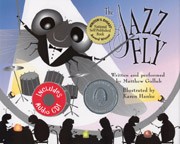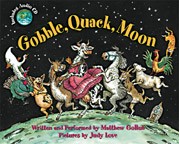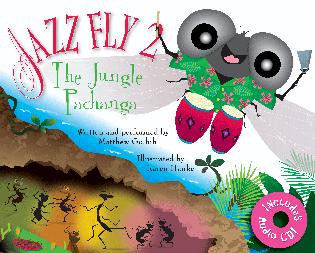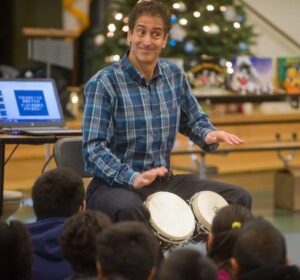My “Creative Jazz Writing Workshops” this summer left me with fodder aplenty to start a new book. As I made the rounds to fourteen (count ‘em!) Migrant Summer School sites in towns like McFarland, Wasco, Taft, Arvin, Lamont, Rosamond, Tehachipi, Shafter, and some lesser known rural districts of Bakersfield, I did storytelling with the younger students (Transitional K, and K-2nd grades), and writing workshops with grades 3-8th.
Over the course of each 50-60 minute writing workshop, I walked the students through some creative writing steps: brainstorming, researching facts as necessary, developing characters, setting up conflict, and letting the plot unfold (like a jazz solo) as the actors and circumstances began to interact…
It helped that their teachers had familiarized them beforehand with The Jazz Fly and Jazz Fly 2: The Jungle Pachanga. When I told students I wanted their help in writing Jazz Fly 3, the exercise seemed to take on more purpose and fun. Conditioned by pop culture, they immediately grasped that Jazz Fly 3 should pick up where Jazz Fly 2 ended, with the Jazz Bugs at sea aboard a luxury cruise ship.
In the spirit of jazz, my objective was to guide the other “players” (i.e. students) toward self-expression. To keep the more imaginative and verbally adept students from monopolizing the exercise, I made it a point to call on as many different individuals as possible. They spoke. I typed. The students seemed to enjoy—and feel empowered—watching me type as fast as my fingers could fly and seeing their own words projected onto the screen. Often after they spoke, I prodded them with questions to help them formulate their ideas more clearly. (“A whale swallowed the ship!” they would say. “OK, were the insects still on board? Did the whale’s throat seem like a long, dark tunnel?”)
I also provided lots of word choices to build on their vocabulary and help them articulate what they wanted to say. (“They got lost at sea ‘cause the captain messed up!” “OK, so was the captain distracted by something? Was he drowsy or inattentive?” “He was drunk!” “OK, so he was intoxicated.”)
To keep everyone engaged, and to minimize idle chatter among students, I told them to use their pencils and paper to write down every word that I typed. For students working hard to learn English as a second language, this turned out to be challenging yet do-able. At the end of the workshop, students took satisfaction in having filled up several pages in their notepads, learning new words and word usages along the way. Here are some of my favorite ideas they proposed for Jazz Fly 3:
–The passengers on the ship are insects and the captain a cockroach.
–Captain Cockroach has a thing for Nancy the Gnat. (This suggestion from an 8th grader.)
–Nancy wears high heels and loses her balance when the ship rocks.
–The ship begins rocking when a storm kicks up waves.
–Then the ship tilts and takes on water.
–The winged insects can’t fly away once their wings get wet.
–The spider monkey and the sloth have stowed away on the ship.
–Only the spider monkey knows how to inflate the life vests.
–The Jamaican insects want the Fly to play reggae music.
–Flying fish, jellyfish, and an emperor penguin rescue The Jazz Bugs.
–They bring them to an island with a volcano that explodes.
Who needs rough drafts when you can write with students by committee?



 "Language, rhythm, color, life!"™
"Language, rhythm, color, life!"™